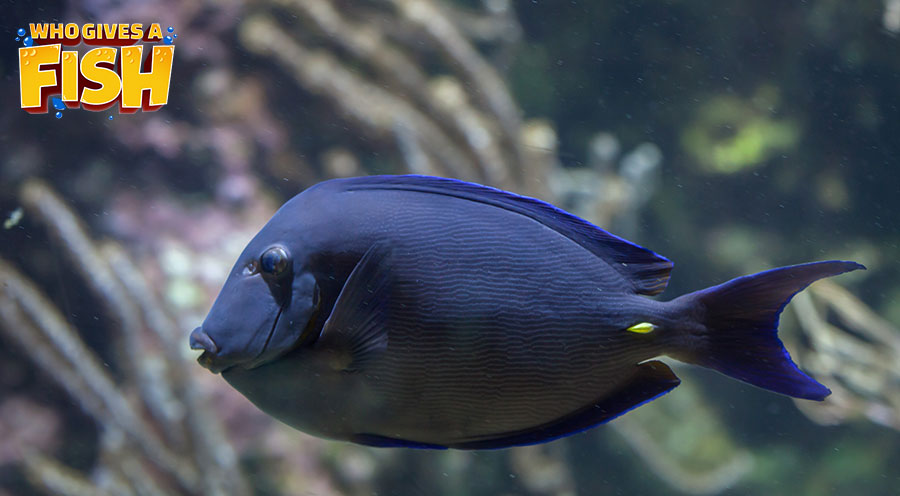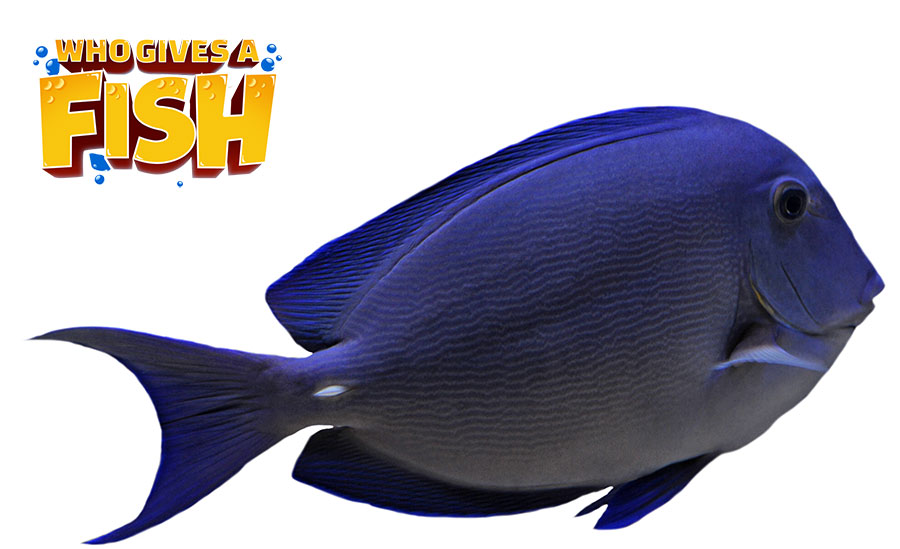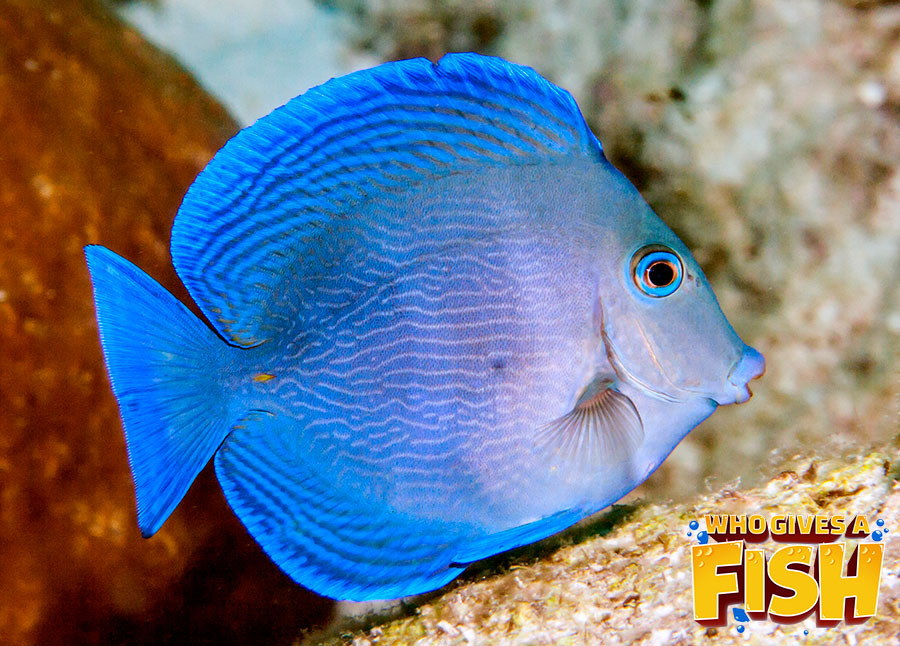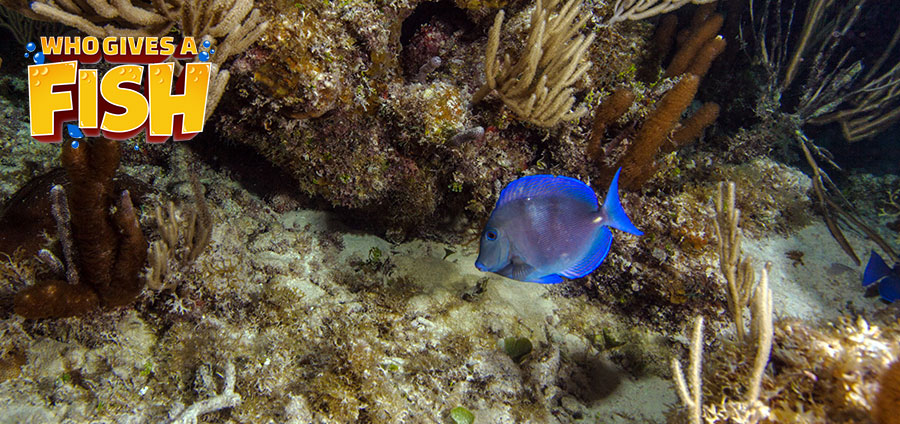Atlantic Blue Tang
The Atlantic Blue Tang Surgeonfish, Acanthurus coeruleus is a stunning tang originating in the Atlantic Ocean. It is a deep-bodied fish that is known to grow fairly large. The common size for this fish is around 9 inches (23 cm), but a few specimens have been known to reach a massive 15 1/3 inches (39 cm) in length. Though not nearly as showy as the two “Blue Tangs” from the Pacific Ocean, it moves through numerous beautiful color stages as it is growing.
- Experience Level: Intermediate
- Hardiness: Sensitive to water conditions
- Minimum Tank Size: 100 gal (379 L)
- Size of fish: 15.4 inches (39 cm)
- Temperament: Semi-aggressive
- Temperature: 72.0 to 79.0° F (22.2 to 26.1° C)
- pH Range: 8.1-8.4
- Diet: Omnivore
Table of Contents
Introduction
Aquarium Setup
Difficulty
Feeding
Breeding and Social
The juvenile is a bright yellow color with blue bordered fins. It then turns into a pastel blue with a hint of yellow in the tail fin, similar to the 2 to 3 inch juvenile seen above. As it starts to reach maturity, it turns a blue accented color with a white or yellow caudal spine.
There can be a wide variation in size when the fish begin to change to their adult blue color, but it is usually at around 5 inches. It is also referred to as the Yellow Doctorfish, Blue Doctorfish, Caribbean Blue and the Blue Surgeonfish.
Juveniles are territorial and solitary in temperament, yet as adolescents they will connect with their relative the Sergeant Major Abudefduf saxatilis damselfish and the Doctorfish Acanthurus chirurgus to graze on algae, and keep a cleaning station in order pick molting skin and parasites from the massive Green Sea Turtle Chelonia mydas. While the other fish are nibbling away at the shell region, this tang focuses primarily on the fleshy areas of the body, concentrating on the turtle’s back and front flippers. They are more inclined to be peaceful as adults and will often live in small groups or pairs, though seldom with more than 10 of their own kind. The adults will also associate with bigger schools combined with other algae eaters to protect areas with decent algae growth.
This Blue Tang is slightly harder to maintain than a few of the other Surgeonfish, but its elegance makes it a splendid addition to the marine aquarium. It is fairly rugged so is a nice pick for an intermediate aquarist, yet it has demands that put it just outside the reach of a novice. Careful attention must be paid to maintaining good water quality and its diet, They require a tank size of at 100 gallons in order to accommodate their swimming needs and size. However, a bigger aquarium that’s 6 foot long and taller or around 180 gallons, will best suit these deep-bodied fish.
They are extraordinarily energetic and frequent grazers and as such, they require to be fed more frequently than a lot of other fish. The tank should have plenty of algae growth and they also need suitable tank mates in order to avoid stress. Just like all tangs, they require clean and excellent condition water in order to stay healthy. Make sure to provide rapid water movement in at least one area of the tank in order for them to exercise by swimming towards the current. They are known to swim at all levels of the aquarium throughout the daytime, and will squeeze themselves between rocks at night-time.
The Atlantic Blue Tang is best housed as the single Surgeonfish that in the tank. It is placid with non-tangs, but it must be one of the final fish added to a placid to semi-combative public tank. It is a good idea not to place them in the same dwelling with other Atlantic Blue Tangs or with Acanthurus. While a few juveniles get along, as they mature, issues with territory can erupt. Only in extremely big tanks, which are able to hold hundreds of gallons, can various types of tangs be housed together. They are then required to be of identical size and characteristics, but different in shape and color.
The magnificent, Atlantic Blue Tang
Aquarium Setup
A big tank is crucial to house the Atlantic Blue Tang and it requires stable, clean water conditions. Surgeonfish are generally not as merciful as a few other fish when it pertains to water quality. Because it requires plenty of food, there is a big bio-load on the aquarium and a tank with a small water volume will become dirty fairly quickly. Frequent water changes done monthly or even bi-weekly will aid in replacing the trace elements that the corals and fish use up. A proposed guideline is to maintain a strict regimen with your water testing, which will let you known when your tank requires a water change.
The Caribbean Blue Tang can be housed in a fish only tank or a reef habitat, although it may nip at some bigger polyped stony corals (LPS). Just like other Surgeonfish, it requires an established and stable tank which is a minimum of 6 months old. This fish is very lively, and will be constantly picking at algae on the various structures in the tank. A tank of at least 100 gallons is recommended, but they generally do better in bigger aquariums as they like plenty of room in order to swim. A bigger 180 gallon tank that is 6 foot long and taller is better suited for their swimming needs and deep-bodied shape. The females are known to reach 15 inches in length, so preparing for a 250 gallon tank would also be advised.
They are known swim in all areas of the tank. The tank should be well adorned with corals and rocks organized with a plethora of caves and crevices for them to hide in at night time. Make sure to provide open areas on the higher levels for them to swim in, with no obstacles. A region of strong, straight water flow is appreciated, as it is pleasing for them to swim against the current. Any substrate is ok, and although soft lighting is known to work, better lighting will help stimulate algae growth. When retained in a reef, these factors require consideration, specifically for the requirements of the coral.
Tangs generate a lot of waste, so the bigger the tank, the simpler it is in order to keep clean and non toxic. A strong protein skimmer and excellent filtration is recommended for long term health. The temperature they prefer is 72° to 79°F (22° to 26°C), normal ocean salinity with a specific gravity of 1.023-1.025, and a pH of 8.1 to 8.4. All of these parameters need to be stable and should not fluctuate.
Atlantic Blue Tang Aquarium Guide
- Minimum Tank Size: 100 gal (379 L) – A minimum of 100 gallons is required for a single fish
- Suitable for Nano Tank: Never
- Live Rock Requirement: Helpful for algae growth
- Substrate Type: Any
- Lighting Needs: Any – They have no special lighting requirements
- Temperature: 72.0 to 79.0° F (22.2 to 26.1° C)
- Specific gravity: 1.023-1.025 SG
- pH Range: 8.1 – 8.4
- Water Movement: High Flow- Provide areas in the tank with good direct flow.
- Water Region: All – They will swim in all areas of the tank and against current/flow. They will hide in structure at night.
Difficulty
The Blue Tang Surgeonfish is fairly easy to care for so long as a few parameters are met. This is a decent sized fish that will usually reach around 9 to 12″ in the first 4.5 years of its life, depending on whether it’s a female or a male. It is a good idea to house it in solitary and requires a tank size of at least 100 gallons, although a taller 180 gallon aquarium would best suit this deep-bodied, active tang the best. If your tang finishes up being one of those 15” specimens, moving it to a tank of at least 250 gallons would be ideal.
Due to the size of the tank and the requirement for decent quality water, it is recommended for an intermediate aquarist. The aquarium should be a minimum of 6 months old, so that it is established and will possess the algae growth required for the tang to feed from. This fish can be placed with non-tangs but should be one of the final fish to be added to a placid to semi-combative public tank. Adding it to a peaceful public reef tank is ok as it will get along with other non-tangs. Three feedings a day, clean water, and a stress free habitat will keep it happy and healthy for a long time.
Surgeonfish that are caught in the wild, and newly acquired tangs are known to suffer from a mixture of external and internal parasites, with poor housing and handling, and a lack of nutrition being the main causes. When choosing your fish, there are a few important things to consider in order to have the best success in keeping it long term. Ensure sure it has been in captivity for some time, it should be active and lively and nibbling at the decor. The coloring should be rich and deep, a pinched stomach is not a fundamental problem and can often be fixed with a decent diet. Be careful, however, if the upper body to the rear of the eyes is sunken in when observed from the front. All Tangs should be placed in solitude for a few weeks after purchase to allow them to rest. This also gives you a chance to watch and treat them for potential diseases before they are introduced to your primary aquarium.
Feeding
Adult Caribbean Blue Tangs are herbivores. When in the wild, they mainly feed on benthic algae such as blue-green algae, brown algae, green algae and red algae, and they are sometimes known to feed on seagrass. They are a notable addition to a reef where they will constantly feed on algae growth. It is imperative that you feed your surgeonfish an assorted diet that consists mainly of high quality vegetable based foods.
In the aquarium these tangs will readily welcome alternate foods, notably algae. After acclimatization they will generally graze on all sorts of foods such as flakes. Present them with pellets, vegetable based flake and thawed/frozen foods combined with spirulina. Dried macro algae, such as Japanese Nori or a few other algae sheet types, can be placed on an aquarium clip for perusing in between feedings. By providing a minimal amount of meaty foods such as krill, brine shrimp, plankton and mysis will aid in adding calories for bulk, specifically as juveniles. Saturate foods in Vitamin C to aid in hindering numerous diseases they are sensitive to. Make sure to feed them at least three times a day.
A few aquarists treat their tangs to zucchini and broccoli or Romaine lettuce and spinach, which can be drifted in the aquarium for feeding. Though these are lovely treats, they may not have enough calories that the staples of prepared foods or natural algae provides. Keeping a small 10 gallon tank in order to grow macro algae is a good plan, so that you can have a steady flow of free food for your fish.
Blue Tang Feeding Guide
- Diet: Herbivore – Use products with Spirulina added if there is not enough algae in the tank.
- Flake Food: Yes
- Pellet / Tablet: Yes
- Live foods (fish, shrimp, worms): While not necessary, the protein will promote bulk/size in growing fish
- Vegetable Food: 90% of their diet
- Meaty Food: 10% of their diet
- Feeding Frequency: Feed adults twice a day and juveniles 3 to 4 times a day
Breeding
Dissimilar to other surgeonfish, male tangs from the Acanthurus genus can be far smaller than the females.
For the last few of decades there have been endeavors in French Polynesia to gather the larvae of a few species as it settles, and then raise the young. Also breeding a few species such as the Naso Tang Naso lituratus, Yellow Tang, Zebrasoma flavescens, and the Regal Tang Paracanthurus hepatus have been tried. However neither of these methods have had adequate success for commercial output. The trouble begins once the eggs hatch. In the pelagic larval state they are extremely small and easily injured, succeeded by an extremely long planktonic larval state, and then the fry are very slow to grow.
The Atlantic Blue Tangs reach sexual readiness at around 9 to 12 months, when they are roughly 4 to 5” long. Spawning is indicated when their bodies change from an all blue to a pale blue front and dark blue rear. When in the wild, they assemble in breeding groups, with some groups reported to be as big as 7,000 individuals off the south west of Puerto Rico. This species also breeds in pairs, where the male retains a region close to the substrate and attains a white-faced color for a very short interval.
Breeding usually begins in the late afternoon or in the early evening, just before the sun sets. The males will antagonistically pursue a mate until a female consents to breed with them. They both swim briskly towards the surface, then release their eggs and sperm together in the open water.
The fertilized eggs are around 0.8 mm around the perimeter and are pelagic and buoyant due to a small drop of oil. After a day, the see-through larvae are thin and flat and shaped similar to a diamond. They have a silver stomach and a triangular head, and move through the ocean grazing on small plankton. Once they reach between 2 to 6 mm in length, they grow anal and dorsal fins and scales. At around 1/2” (13 mm) they grow a caudal spine which they utilize for as a shield.
These small fry float towards the shore line of the ocean, where they change into little juveniles. Their silver coloring then turns brown, their snout gets longer to prepare for feeding and their diamond shape turns round. Within a week they turn a yellow color, and are around 2” in length.
Social
The Blue Tang Surgeonfish is best kept singly and as the only surgeonfish in the tank. Whilst they are found in small bunches in the wild, they show no leniency for their own kind in while captivity unless you have a tank the size of a community aquarium. It is also a good idea to not place them with other Acanthurus genus tangs due their similar shape, which will bring out their combative nature. They will also not get on well with other sorts of tangs unless the tank is particularly large. Even then they must be of distinct colors and shapes, but with the same characteristics.
The Caribbean Blue Tang is placid with non-tangs, but ideally it should be one of the final fish added to a placid to semi-combative public tank. It can be housed with somewhat placid fish and smaller semi-combative fish. Anthias and the Clownfish are ideal tank mates that will keep it disease free, calm and happy. Other placid fish, even smaller gobies will not be disturbed by this tang. Larger angelfish that are not eaters of algae, but are however placid planktivores, can be ok but should ideally be added to the tank prior the tang. Do not place them with combative damsels, particularly when the tang is young. Triggers are usually too combative, unless they are planktivores.
Surgeonfish are ideal in a reef habitat in order to control algae growth. But with this particular species, the Large Polyp Stony Corals (LPS) can be targets of nipping unless the tang is well fed. They may also feed on the algae at the stony base, which is not the same as eating the coral. Invertebrates are harmless, although there have been uncommon reports where a tang has been known to nibble at the mucus of a clam, motivating it to stay closed.





